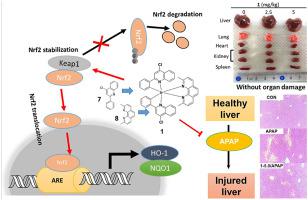Redox Biology ( IF 11.4 ) Pub Date : 2021-09-10 , DOI: 10.1016/j.redox.2021.102129 Guodong Li 1 , Hao Liu 2 , Ruibing Feng 1 , Tian-Shu Kang 1 , Wanhe Wang 3 , Chung-Nga Ko 2 , Chun-Yuen Wong 4 , Min Ye 5 , Dik-Lung Ma 2 , Jian-Bo Wan 1 , Chung-Hang Leung 6

|
Hepatotoxicity caused by an overdose of acetaminophen (APAP) is the leading reason for acute drug-related liver failure. Nuclear factor erythroid-2-related factor 2 (Nrf2) is a protein that helps to regulate redox homeostasis and coordinate stress responses via binding to the Kelch-like ECH-associated protein 1 (Keap1). Targeting the Keap1-Nrf2 interaction has recently emerged as a potential strategy to alleviate liver injury caused by APAP. Here, we designed and synthesized a number of iridium(III) and rhodium(III) complexes bearing ligands with reported activity against oxidative stress, which is associated with Nrf2 transcriptional activation. The iridium(III) complex 1 bearing a bioactive ligand 2,9-dimethyl-1,10-phenanthroline and 4-chloro-2-phenylquinoline, a derivative of the bioactive ligand 2-phenylquinoline, was identified as a direct small-molecule inhibitor of the Keap1–Nrf2 protein-protein interaction. 1 could stabilize Keap1 protein, upregulate HO-1 and NQO1, and promote Nrf2 nuclear translocation in normal liver cells. Moreover, 1 reversed APAP-induced liver damage by disrupting Keap1–Nrf2 interaction and without inducing organ damage and immunotoxicity in mice. Our study demonstrates the identification of a selective and efficacious antagonist of Keap1–Nrf2 interaction possessed good cellular permeability in cellulo and ideal pharmacokinetic parameters in vivo, and, more importantly, validates the feasibility of conjugating metal complexes with bioactive ligands to generate metal-based drug leads as non-toxic Keap1–Nrf2 interaction inhibitors for treating APAP-induced acute liver injury.
中文翻译:

一种生物活性配体偶联的铱(III)金属基复合物作为 Keap1-Nrf2 蛋白-蛋白相互作用抑制剂对抗对乙酰氨基酚诱导的急性肝损伤
过量服用对乙酰氨基酚 (APAP) 引起的肝毒性是急性药物相关肝功能衰竭的主要原因。核因子 erythroid-2 相关因子 2 (Nrf2) 是一种蛋白质,通过与 Kelch 样 ECH 相关蛋白 1 (Keap1) 结合,有助于调节氧化还原稳态和协调应激反应。靶向 Keap1-Nrf2 相互作用最近已成为减轻 APAP 引起的肝损伤的潜在策略。在这里,我们设计并合成了许多带有配体的铱 (III) 和铑 (III) 复合物,据报道具有抗氧化应激的活性,氧化应激与 Nrf2 转录激活相关。铱(III)配合物1带有生物活性配体 2,9-二甲基-1,10-菲咯啉和 4-氯-2-苯基喹啉(生物活性配体 2-苯基喹啉的衍生物)被鉴定为 Keap1-Nrf2 蛋白的直接小分子抑制剂 -蛋白质相互作用。1可以稳定Keap1蛋白,上调HO-1和NQO1,促进正常肝细胞Nrf2核转位。此外,1通过破坏 Keap1-Nrf2 相互作用来逆转 APAP 诱导的肝损伤,并且不会在小鼠中引起器官损伤和免疫毒性。我们的研究表明,Keap1-Nrf2 相互作用的选择性和有效拮抗剂的鉴定在纤维素中具有良好的细胞渗透性和理想的体内药代动力学参数,更重要的是,验证了将金属配合物与生物活性配体结合以产生基于金属的药物先导物作为无毒 Keap1-Nrf2 相互作用抑制剂治疗 APAP 诱导的急性肝损伤的可行性。



























 京公网安备 11010802027423号
京公网安备 11010802027423号